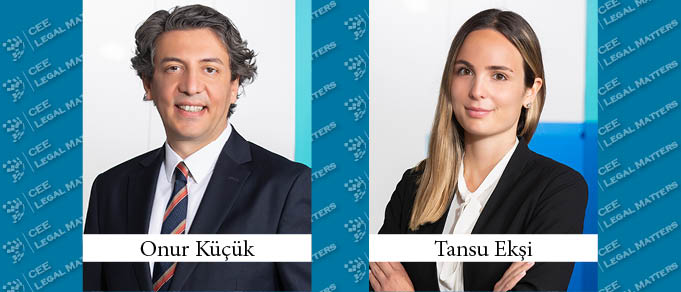Recent developments such as economic crises, pandemics, climate crisis, green transformation and the increasing importance of compliance with strategies such as European Green Deal necessitates a sustainable and innovative finance approach in the world and in our country's capital markets. Therefore, the need for long-term funds to finance the investments required for the transition to a low-carbon economy and projects that contribute to environmental sustainability increases the importance of capital markets. In order to accelerate the sustainable development of our country, in the 2022 target announcements and draft guidelines of the Turkish Capital Markets Association and the Capital Markets Board; it is seen that innovative capital markets financing products related to environmental and social problems such as climate change are supported.
Within the framework of the 11th Development Plan, the 2021 Economic Reform Package and the Paris Climate Agreement priorities and actions, The Guidelines on Green Debt Instruments, Sustainable Debt Instruments, Green Lease Certificates and Sustainable Lease Certificates (“Guidelines”), which was opened for discussion as a draft in 2021, was accepted and published with the decision dated February 24, 2022. Thus, a concrete action was taken to increase the issuance of green debt instruments and green lease certificates in the capital markets, to increase investor confidence with the anticipated external evaluation obligations, and most importantly, to encourage more investments in sustainable projects.
What Does the Guidelines Regulate?
The Guidelines aims to make sure that green debt instruments, sustainable debt instruments, green lease certificates and sustainable lease certificates are issued in compliance with the best practices and standards in international financial markets. In this direction, this Guidelines is prepared on the basis and targets of the International Capital Markets Association (ICMA) Green Bond Principles and Paris Climate Agreement which are the most widely accepted and global standard regulations in financial markets in the field of green bonds.
The Guidelines sets down and regulates the core elements of and the principles that must be followed for green debt instruments and green lease certificates and the principles that must be followed in the domestic issue of these instruments and also in the foreign issue thereof. The general bases, principles and obligations specified for green debt instruments within the scope of the Guidelines also apply to sustainable debt instruments, as well as green lease certificates and sustainable lease certificates.
Obligations determined for the issuers in the Guidelines shall be fulfilled by asset leasing company and/or fund user in green/sustainable lease certificate issues. As for the obligations imposed on issuers under the Guidelines, the responsibilities of asset leasing company and/or fund user are required to be determined and listed in the framework document, in course of applications submitted to the Capital Markets Board (“Board”). It is also stated that the capital market instruments covered by this Guidelines are subject to and governed by the related Communiqués of the Board in terms of general principles and issuance processes.
Sample framework documents and summary reports are included in the annex to the Guidelines.
Green Debt Instruments
As per the definitions in the Guidelines, green debt instruments are debt instruments, whose proceeds will be used exclusively for partial or total financing or refinancing of new and/or existing green projects in conformity with the eligible green project definition. Green bonds and lease certificates defined in the Communiqué on Lease Certificates numbered III-61.1 are also included in the scope of the Guidelines, and with the definition of the Board, green bonds are bonds that create resources for the financing of projects that provide positive benefits to the environment or climate. Lease certificates are the securities issued by the asset leasing company in order to finance the asset and right, and which enable their owners to be entitled in proportion to their share of the income obtained from this asset or right. Lease certificates, blue debt instruments, asset and mortgage-backed securities, asset and mortgage-backed securities and project-backed securities are also considered green/sustainable capital market instruments, provided that they meet the qualifications set forth in this Guidelines and that the obligations are fulfilled by the issuers.
Under Which Conditions Does a Debt Instrument Becomes a "Green Debt Instrument"?
The difference between green debt instruments and other debt instruments is that they are used for green projects. The projects that contribute to environmental objectives, such as mitigation of effects of climate change, adaptation to climate change, protection of natural resources, protection of biodiversity and control and prevention of pollution are considered as eligible green projects.
Provided that the below mentioned conditions are met, the issuer will be permitted to use the term ‘green debt instrument’, ‘sustainable debt instrument’, ‘green lease certificate’ or ‘sustainable lease certificate’ for the debt instrument to be issued:
(i) The issuer shall confirm in the framework document that the issues covered by the framework document will be conducted in accordance with the principles set out in the Guidelines.
(ii) Proceeds from the issue as specified in the framework document shall be used exclusively to finance or refinance, partially or wholly, new and/or existing green projects that meet the definition of green projects given in the relevant section of this Guidelines.
(iii) The compliance of the green debt instrument framework document with the Guidelines shall be reviewed and evaluated by a second party opinion.
The framework document and the second party opinion shall be made public in the Public Disclosure Platform (PDP) if the issuer is a member of PDP and issuer’s internet site together with issue document relating to the ceiling of issue or prospectus.
What are the Core Components?
1) Use of Proceeds Obtained from the Issue: Funds obtained from the issue of green debt instruments shall be used for green projects as soon as possible, and the period predicted for use of said funds must be stated in the framework document. Eligible green project types are as listed below, without however being limited thereto:
- Renewable energy (including generation, transmission, devices and products), and
- Energy efficiency (such as new and renovated buildings, energy storage, central heating, smart grids, devices and products), and
- Prevention and control of pollution (including reduction of atmospheric emissions, greenhouse gas control, soil remediation, waste prevention, waste reduction, waste recycling and energy/emission-efficient wastes-to-energy conversion), and
- Environmentally sustainable management of living natural resources and land use (including environmentally sustainable agriculture, environmentally sustainable livestock, climate-related smart farm inputs such as biological plant protection or drip irrigation, environmentally sustainable fisheries and aquaculture, and environmentally sustainable forestry, and conservation or restoration of natural landscapes), and
- Conservation of terrestrial and aquatic biodiversity (including protection of coastal, marine and basin environments), and
- Clean transport (such as electric, hybrid, public, rail, non-motorised, multi-modal transport, infrastructure for clean energy vehicles, and reduction of harmful emissions), and
- Sustainable water and wastewater management (including sustainable infrastructure for clean and/or drinking water, wastewater treatment, sustainable urban drainage systems and river reclamation, and other forms of flood reduction), and
- Climate change adaptation (including information support systems such as climate monitoring and early warning systems, as well as efforts and initiatives aiming to make the infrastructures more resilient against effects of climate change), and
- Eco-efficient products, production technologies and processes and/or products, production technologies and processes adapted to circular economy (such as eco-labels or environmental certification, resource-efficient packaging and distribution, and development and promotion of environmentally sustainable products), and
- Green buildings that meet the requirements of regional, national or internationally recognised standards or certificates.
2) Project Evaluation and Selection Process: The evaluation and selection process should be explained to the investors along with the elements determined in the Guidelines. Of these elements, those that are not advisory but should be included in the framework document are (i) Relations of eligible green project types with such international covenants as United Nations Sustainable Development Goals and Paris Climate Deal; (ii) Information on how the issuer has determined that eligible projects fall within the scope of the green project types defined above, (iii) Description of qualitative and quantitative impact criteria to be used in order to indicate the important contributions made by each of the criteria used in selection of green projects to the related environmental objectives, (iv) Information of the processes implemented to identify and manage potential environmental and social risks associated with different types of green projects. As can be understood from this, the Board attaches great importance to international commitments in the field of sustainability.
3) Management of Proceeds Obtained from the Issue: As long as the green debt instrument is in circulation, net fund balance is managed by allocation to the eligible green projects in the relevant period. The part that should be managed by allocating it exclusively to the relevant project is important. The issuer shall disclose in the framework document how it intends to manage the unused net fund balance until allocation to the relevant green projects ( reinvestment principles in short-term financial instruments and liquid assets). Proceeds obtained from the issue of green debt instruments can be managed on a per-issue basis (i.e. for a single green debt instrument) or be aggregated for more than one green debt instrument (portfolio approach).
4) Reporting: At least once a year starting from the date of issue and in any case, after allocation of the full amount of proceeds obtained from the issue, the issuers are required to make public the fund allocation report that is covering current information as to use of proceeds, as well as information on material events and developments, if any, at the issuer’s internet site, and if the issuer is a member of PDP, in PDP within the frame of the Board’s regulations pertaining to public disclosure of material events and developments. At least once a year starting from the date of issue and in any case, after allocation of the full amount of proceeds obtained from the issue, the issuers are required to make public by the aforementioned procedure in the form of an impact report covering the estimated and/or actual environmental impacts.
External Review
The external review service that the issuers can receive during the green debt instrument issuance process is offered in four basic groups. Issuers can receive external evaluation services in the form of (i) second-party opinion, (ii) verification, (iii) certification and (iv) green debt instrument scoring/rating, in accordance with the ICMA External Review Guidelines during the issuance process.
Issuers can obtain this service from organizations providing external review services that meet the criteria specified in the Guidelines, in line with the principles of honesty and integrity, objectivity, professional competence, care and confidentiality, as well as the professional standards and industry codes listed in the Guidelines.
Process in International Issuances
In applications filed for issuance of green debt instruments abroad, the framework document, prepared in accordance with the international green bond/green sukuk standards (standards) to which the issue is subject to, and approved by the board of directors, as well as the second-party opinion confirming the compliance of said document with the relied upon foreign standards are required to be submitted to the Board, and to be published, together with the issue document, in the issuer’s internet site, and if the issuer is a member of Public Disclosure Platform (PDP), in PDP.
Post issuance Turkish translation of fund allocation reports complying with the relevant international standards is required to be published in the issuer’s internet site, and/or if the issuer is a member of Public Disclosure Platform (PDP), in PDP, within three months following the date of preparation. Also in the green issuances to be realized abroad under this Guidelines, a separate ceiling of issue is required to be received from the Board.
Recent News in the Market
Türkiye Kalkınma ve Yatırım Bankası Anonim Şirketi has announced that they have provided loans of approximately 11 Billion 697 Million TRY to 476 renewable energy investment projects with an installed capacity of approximately 3,639 MW as of May 31, 2020. According to the PDP statement, it will take part as an issuer in green and sustainable debt issuances. It will be realized abroad, without public offering, through one or more issuances. It is planned to issue green and sustainable bonds, bills and similar debt instruments up to a maximum of 400 million USD or equivalent foreign currency or Turkish lira in total.
Türkiye İş Bankası Anonim Şirketi, with its statement published on the Public Disclosure Platform on 27.05.2022, announced that it will issue green and/or sustainable bonds, bills and debt instruments up to a total of 1.5 billion USD or its equivalent in other currencies, including Turkish Lira, to be issued abroad.
With the publication of the guidelines, it is predicted that these examples and green bond issuances will increase in the coming period.
By Onur Kucuk, Managing Partner, and Tansu Eksi, Associate, KP Law















